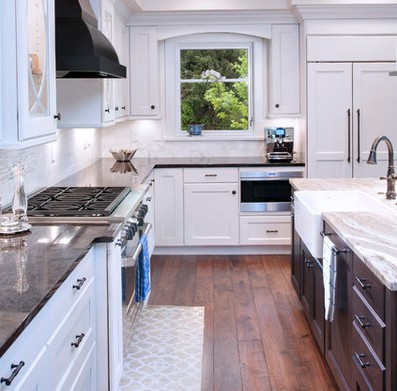Work surfaces and splashbacks can account for around 20 to 30 per cent of the visual area of your kitchen. So it’s important to get the choice of material and colour right. Your first step should be to set your budget. Next, visit a reputable kitchen showroom and talk to a professional about which material is right for you. Think ahead about your personal style and how you use your kitchen to save time.
Laminate benchtops have become one of the most popular options on the market as they offer the best value for money. Construction from a core material, commonly chipboard. They feature a printed decorative layer covered by clear plastic. which provides a hard-wearing surface.
A limitation of laminate is that you can only install an overmount not an undermount sink. An undermounted sink requires the edges of the benchtop to be visible and watertight. But with laminate, typically, you won’t get a finished edge suitable for use so close to a sink
The part you don't see in benchtop
All laminates are not created equal. The part you don’t see – the core – needs to be good quality if your benchtop is to last. But not all manufacturers focus on this. The ‘better’ laminate benchtops have cores that vary in density. The surface layers are denser and stronger. So less likely to suffer impact damage if a pan is dropped on them. A less dense structure is used in the middle to avoid the benchtop from becoming too heavy.
Quality laminates also prevent spills from running along the base of the benchtop and into the cupboards beneath.
Wood as a good-value alternative to laminate. It adds character to a contemporary or traditional kitchen. And it’s a hygienic choice because of its antibacterial properties. Timbers are available at various price points, so there’s almost certainly a wooden benchtop for your budget. Plus, wood is a good return on your investment because it can last for many years when it’s cared for.
Common complaints about wood include that it’s easily scorch, scratch and stain. Wood can swell if it gets very damp. So, if your heart is set on a wooden benchtop. Think about having a small section of a different material in the sink area, as seen in this kitchen.
Material used for fabrication
Templating refers to benchtops that are fabricate in a factory and delivered ready to fit. For stone, engineer stone or solid surface materials. This is essential as it’s not always possible to cut them on site.
Wood and laminate are generally easier to fit and can be cut on site to accommodate stovetops, sinks and plug points.
In the past, the choice [for benchtops] was either a natural material or limited man-made material at extreme spectrums in terms of cost. With the advances in benchtop technology, there are many options of composites. Although composites don’t come cheap, there are ways to cut costs. But first, what are composites and why might they be worth investing in?
Among the composites available is engineer stone. Which combines the natural beauty of stone with the technical and performance benefits of a precision-engineer material. Being man-made, with a mix of quartz and resin, the material is colour consistent. Harder-wearing than granite and stone, and highly resistant to stains, scratches and impact. It’s easy to clean with a simple wipe down and needs little ongoing maintenance. It can also be cut, shaped and routed, giving wide design flexibility.
Concluding
Another composite is solid surface. This is generally made of a blend of minerals and acrylic. The result is a hard surface that can be mould into any shape. Solid surface benchtops can be seamlessly joint. So there are no visible joints and grooves. It’s even possible to carve out a draining board because the colour runs all the way through.
Variety won’t just add interest to your kitchen, it’ll also make it more cost effective. Rarely will just one benchtop satisfy a whole kitchen design. Zoning is important and also helps your budget stretch further. Think about placing hard-wearing stone beside sinks and stoves, and use more affordable laminates elsewhere. If you want to warm up your kitchen with wood – a porous material – steer clear of high-traffic areas and confine it to the breakfast bar.

